Content for TS 23.401 Word version: 19.1.0
1…
4…
4.2.2…
4.3…
4.3.6…
4.3.8…
4.3.12…
4.3.16…
4.3.20…
4.3.25…
4.4…
4.6…
4.7…
4.13…
5…
5.1.2…
5.3…
5.3.2…
5.3.3…
5.3.3.2
5.3.3.3…
5.3.4…
5.3.4B…
5.3.5…
5.3.8…
5.3.9…
5.4…
5.4.4…
5.5…
5.5.1.2…
5.5.2…
5.5.2.2…
5.5.2.3…
5.5.2.4…
5.6…
5.7.3…
5.7A…
5.10
5.11…
5.19…
D…
D.3…
D.3.4
D.3.5
D.3.6
D.3.7…
D.3.8…
E
F…
J…
K…
L…
M…
O…
5 Functional description and information flows
5.1 Control and user planes
5.1.0 General
5.1.1 Control Plane
...
...
5 Functional description and information flows p. 129
5.1 Control and user planes p. 129
5.1.0 General |R9| p. 129
5.1.1 Control Plane p. 129
5.1.1.1 General p. 129
The control plane consists of protocols for control and support of the user plane functions:
- controlling the E-UTRA network access connections, such as attaching to and detaching from E-UTRAN;
- controlling the attributes of an established network access connection, such as activation of an IP address;
- controlling the routing path of an established network connection in order to support user mobility; and
- controlling the assignment of network resources to meet changing user demands.
5.1.1.2 eNodeB - MME p. 129
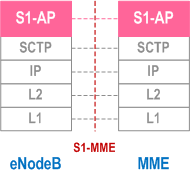
Legend:
- S1 Application Protocol (S1-AP): Application Layer Protocol between the eNodeB and the MME.
- Stream Control Transmission Protocol (SCTP): This protocol guarantees delivery of signalling messages between MME and eNodeB (S1). SCTP is defined in RFC 4960.
5.1.1.3 UE - MME p. 130
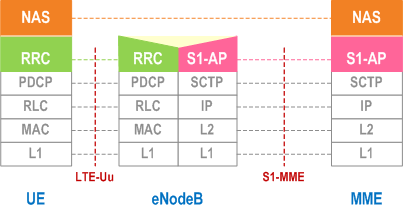
Legend:
- NAS: The NAS protocol supports mobility management functionality and user plane bearer activation, modification and deactivation. It is also responsible of ciphering and integrity protection of NAS signalling.
- LTE-Uu: The radio protocol of E-UTRAN between the UE and the eNodeB is specified in TS 36.300.
5.1.1.4 SGSN - MME p. 130
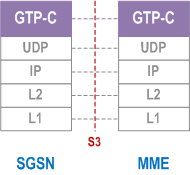
Legend:
- GPRS Tunnelling Protocol for the control plane (GTP-C): This protocol tunnels signalling messages between SGSN and MME (S3).
- User Datagram Protocol (UDP): This protocol transfers signalling messages. UDP is defined in RFC 768.
5.1.1.5 SGSN - S-GW p. 131
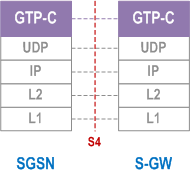
Legend:
- GPRS Tunnelling Protocol for the control plane (GTP-C): This protocol tunnels signalling messages between SGSN and S-GW (S4).
- User Datagram Protocol (UDP): This protocol transfers signalling messages. UDP is defined in RFC 768.
5.1.1.6 S-GW - P-GW p. 131
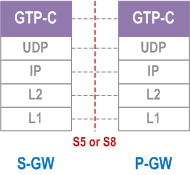
Legend:
- GPRS Tunnelling Protocol for the control plane (GTP-C): This protocol tunnels signalling messages between S-GW and P-GW (S5 or S8).
- User Datagram Protocol (UDP): This protocol transfers signalling messages between S-GW and P-GW. UDP is defined in RFC 768.
5.1.1.7 MME - MME p. 132
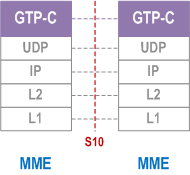
Legend:
- GPRS Tunnelling Protocol for the control plane (GTP-C): This protocol tunnels signalling messages between MMEs (S10).
- User Datagram Protocol (UDP): This protocol transfers signalling messages between MMEs. UDP is defined in RFC 768.
5.1.1.8 MME - S-GW p. 132
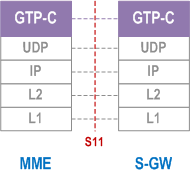
Legend:
- GPRS Tunnelling Protocol for the control plane (GTP-C): This protocol tunnels signalling messages between MME and S-GW (S11).
- User Datagram Protocol (UDP): This protocol transfers signalling messages. UDP is defined in RFC 768.
5.1.1.9 MME - HSS p. 133
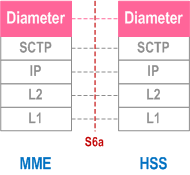
Legend:
- Diameter: This protocol supports transferring of subscription and authentication data for authenticating/authorizing user access to the evolved system between MME and HSS (S6a). Diameter is defined in RFC 3588.
- Stream Control Transmission Protocol (SCTP): This protocol transfers signalling messages. SCTP is defined in RFC 4960.
5.1.1.10 MME - EIR p. 133
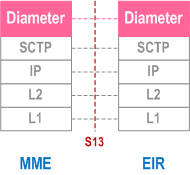
Legend:
5.1.1.11 Void
5.1.1.12 MME - CSS |R11| p. 134
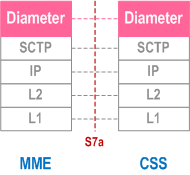
Legend:
5.1.1.13 MME - RCAF |R13| p. 134
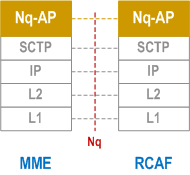
Legend:
- Nq-AP: This application layer protocol supports the IMSI and APN retrieval procedure between the RCAF and the MME.
- Stream Control Transmission Protocol (SCTP): This protocol transfers signalling messages. SCTP is defined in RFC 4960.